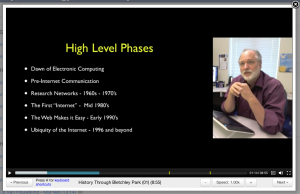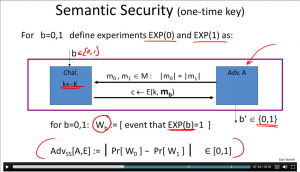Getting to Know Coursera: Video Lectures
By Katie McEwen, Graduate Assistant
Next semester Vanderbilt will begin offering its first round of massive open online courses (MOOCs) as a part of the Coursera consortium. Now 33 universities strong, Coursera lists 198 courses over fifteen different disciplines: from medicine to computer science; physical and earth sciences to humanities and social sciences, Coursera seems to have it all.
But what does a typical course look like? Is there even such a thing as “typical” in this setting?
The answer, surprisingly enough, is yes. In fact, in matters of form Coursera courses often have more in common than not, despite the wide variety of disciplines and topics. Over the next few posts, we’ll take a look at some of these shared features, beginning with video lectures.
In some respects, taking a Coursera course is not so very different from enrolling in just about any large lecture course in the tradition of the teacher-centered classroom. Without, of course, the stadium seating.


Video lectures are by far the most common method of presentation in Coursera. Having spent most of my academic career studying German — a discipline whose largest course here at Vanderbilt enrolls 60 students — this was, at first, somewhat alienating. How could this be engaging to watch? I was skeptical to say the least.
Luckily, most instructors seem comfortable in the medium, using screencasts with audio or video narration to present material. Although the pre-recorded narration can, in some cases, come across as slightly wooden, just as often it is surprisingly enthusiastic as instructors delve into their subject. As in the traditional classroom, slides summarize key material, supplemented with annotations in digital ink (also not a feature of your usual German classroom), less frequently with images, videos, or links. For the first time, I began to truly appreciate a pithy, well organized Powerpoint slide.
A few courses take a slightly different tack, filming and editing live in-class lectures. As in class, the ultimate success of this approach depends to large degree on the charisma of the lecturer, with big personalities translating well into the video format. Indeed, personality is especially important here, since high video quality — for example, lighting, focus, sound — is more difficult to achieve.
Coursera video lectures — in whatever format — are short and interactive. Video lectures are only 8 to 15 minutes long, breaking up each course unit into multiple thematic “chunks”: much easier to digest than a single, long presentation. And video lectures can be rewound, re-watched, stopped, started, sped up or slowed down, viewed with or without subtitles — all at the click of a button. This gives students an amount of control virtually impossible to facilitate in a lecture hall.

Ungraded interactive quiz questions pop up to test recall in each lecture “chunk.” No grade is given for these questions, and students may choose to skip them altogether or merely guess their way through. Yet, the questions do gesture toward keeping students involved in the lecture, and provide them with an easy method to check understanding. One course even synchronizes these questions in Coursera with the clicker and discussion questions posed in lecture, allowing students in the Coursera course to compare answers with those of the shadowy students filmed in lecture in Philadelphia. A rather uncanny experience.
Even though video lectures are the most common method of presentation in Coursera, next time we’ll take a look at a different approach: the video discussion.

Leave a Response